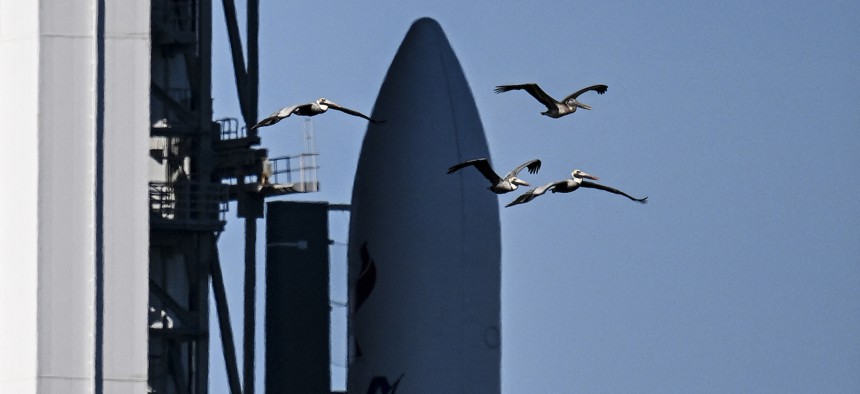AUDREY DECKER

United Launch Alliance successfully launched its much-anticipated heavy-lift rocket, a key step in its plans to compete against launch titan SpaceX.
The first flight test and certification mission for ULA’s Vulcan Centaur rocket lifted off from Cape Canaveral Space Force Station in Florida at 2:18 a.m. on Jan. 8, company officials said.
Vulcan will be “very competitive” in the space market because it has the capabilities of the Atlas V and Delta IV rockets combined into one system, officials said.
“Vulcan is really designed to support a full range of missions across all the markets that we serve, commercial, civil and national security, and because we do have that adjustability in its configuration can be really tailored to the specific mission,” Mark Peller, ULA vice president of Vulcan development, told reporters Friday ahead of the launch.
But even with Vulcan entering the launch market, SpaceX will still have an advantage over ULA once SpaceX’s Starship mega-rocket becomes operational. Starship will “have an order of magnitude larger payload capacity than Vulcan and a cost per pound that much less than even the Falcon 9,” said Todd Harrison, a senior fellow at the American Enterprise Institute.
“I don't see any scenario in which Vulcan becomes cost-competitive with Falcon 9 or Starship, and a big reason is that it is not designed for reusability. What will keep Vulcan alive is U.S. military policy that says they want to have at least two launch providers, and commercial customers that want to avoid becoming dependent on Elon Musk—like Amazon. Once Blue Origin's New Glenn enters service and gets qualified to launch military satellites, all bets are off,” Harrison said.
However, ULA is looking at reusing the engines “downstream,” Peller said, maintaining that the current version of Vulcan is competitive regardless.
“We're operating in a competitive marketplace and we must continue to always improve our product offering and the opportunity with reuse…is a significant opportunity to enhance our competitiveness down the road,” Peller said.
ULA had a slow year in 2023, launching a total of three rockets, partly because it’s transitioning from its legacy rockets to Vulcan.
In contrast, SpaceX dominated the 2023 launch market: out of 104 successful U.S. launches, 96 were by Elon Musk’s company, according to an annual report on global space activities by Jonathan McDowell, an astrophysicist working at the Harvard-Smithsonian Center for Astrophysics.
A joint Lockheed Martin-Boeing venture, ULA had a monopoly on space launch until SpaceX came onto the scene in the 2010s, offering its Falcon 9 at a cheaper price than ULA’s Atlas V. Falcon 9 has since become the workhorse in the market for medium and heavy launch vehicles.
The launch of ULA’s new Vulcan rocket has been pushed back several times, in part due to delays in developing the main engine, BE-4, which is supplied by Jeff Bezos’s Blue Origin, and also because of a post-qualification-test explosion in March 2023.
The company uses a very traditional development and engineering approach, which has led to long timelines but also means it will likely work on the first try, Harrison said.
The Monday launch is one of two certification flights ULA must complete before it can start flying missions for the Space Force. If all goes well in the first flight, the company aims for the second in April.
“We need to get through two flights and we will evaluate the data and we expect that will put us on a path to complete our national security space launch certification,” Peller said.
Vulcan’s first national security mission will be USSF-106, which will launch an experimental navigation satellite to geostationary-Earth orbit and also include a classified program. The satellite, Navigation Technology Satellite-3, NTS-3, is built by L3Harris and funded by the Air Force Research Laboratory.
Vulcan has six launches planned in 2024, four of which are national security missions, Peller said. Once the new rocket is up and running, ULA plans to increase its cadence to 28 launches in 2025.
“We're also putting in place a secondary capability where we can do vertical integration of a second vehicle in parallel, and once that capability is brought on board our flight rate will increase above the current flight rates,” Peller said.
No comments:
Post a Comment